Abstract
In this study, prediction of the future land use land cover (LULC) changes over Mumbai and its surrounding region, India, was conducted to have reference information in urban development. To obtain the historical dynamics of the LULC, a supervised classification algorithm was applied to the Landsat images of 1992, 2002, and 2011. Based on spatial drivers and LULC of 1992 and 2002, the multiple perceptron neural network (MLPNN)-based Markov chain model (MCM) was applied to simulate the LULC in 2011, which was further validated using kappa statistics. Thereafter, by using 2002 and 2011 LULC, MLPNN-MCM was applied to predict the LULC in 2050. This study predicted the prompt urban growth over the suburban regions of Mumbai, which shows, by 2050, the Urban class will occupy 46.87% (1328.77 km2) of the entire study area. As compared to the LULC in 2011, the Urban and Forest areas in 2050 will increase by 14.31% and 2.05%, respectively, while the area under the Agriculture/Sparsely Vegetated and Barren land will decline by 16.87%. The class of water and the coastal feature will experience minute fluctuations (<1%) in the future. The predicted LULC for 2050 can be used as a thematic map in various climatic, environmental, and urban planning models to achieve the aims of sustainable development over the region.
1. Introduction
Land is among the essential environmental resources that support human life. For the last several decades, the global trend of economic development and a rising population have elicited abrupt alterations in the Earth’s terrestrial surfaces. There exist indications that the rate of these changes will accelerate in the near future. The modifications in Earth’s surfaces caused by anthropogenic activities are generally recognized as land use and land cover (LULC) alterations [1]. Though the words LULC is frequently used and interchangeably applied, they are fundamentally different.
1.1. Land Use and Land Cover
Land use is a term that describes how people utilize the land for various socioeconomic prospects (agriculture, settlement, etc.), whereas land cover indicates the (bio)physical conditions of the land surfaces (forest, wetland, etc.) [2,3]. Recently, due to human intrusions, greater than 40% of the globe’s land cover has been modified to other types of land uses [4,5]. These alterations in LULC have mainly been driven by factors like topography, climatic, socioeconomic, etc. The changes in the spatial scale of LULC vary from meters to a global extent, while its temporal range fluctuates from few days to several ages. In the past few decades, after studying the direct and indirect impacts of LULC alterations on climate and environmental processes, studies related to the spatiotemporal evaluation of LULC gained much more importance. The results of many previous studies show that the various changes in environment like emission of greenhouse gases, rise in temperature, loss of biodiversity, and water resources are closely associated with the LULC modifications [6,7,8,9,10].
Some studies also reported that the in vagaries in precipitation trends and runoff, urban heat island, human–animal conflict, land degradation, inhalation of ultra-fine particulate matter, etc. are some of the local scale meteorological and environmental issues which mainly arise due to the fluctuations in LULC [6,7,8,9,10,11,12]. Besides its impact on the natural processes, changes in LULC also have a two-way relationship with the various socioeconomic factors (food production, land prices, employment opportunities, etc.) that are closely associated with the life of human beings [13]. Thus, to attain the aims of sustainable development, knowledge of the past, present, and forthcoming trends in LULC contribute significantly to several fields like urban planning, meteorology, policy-making, etc.
The information related to current and past LULC can be derived by using two approaches, i.e., conventional and remote sensing approaches. In the conventional method, LULC information is retrieved by compiling the revenue records of the region that are collected by the respective government authority. Generally, this information of LULC is available in the form of statistical records without any reference to the spatial locations. At different spatial scales, topographical/soil maps from the surveying organization also give the LULC associated data. However, such maps do not reflect the detail and current scenario of the region. These datasets come with various limitations such as partial data coverage, varying data age, the local level definition of the classification system, etc. These limits of the conventional approach in the creation of LULC data can be overcome by adopting the second approach, i.e., remote sensing. At various spatio-temporal scales, a combination of remote sensing and geographical information system (GIS) is the most suitable technique for monitoring and evaluating the LULC information. Several researchers have described the efficiency of this approach for assessing LULC changes [14,15,16]. As compared to the conventional method, technology associated with the remote sensing approach helps for fast acquisition of data to retrieve LULC information continuously at a lesser cost with more details. Thus, in the current study, a remote sensing technique was adopted to acquire the LULC information and to carry out the LULC change analysis.
1.2. LULC Simulation and Prediction
The comparative analysis of past and current LULC with a future can be utilized to overcome the several issues associated with urban growth, modification of climate, environmental processes, land use problems, food security, urban planning, etc. Previously, several models have established to imitate and predict the future pattern of LULC. Commonly used models for predicting future LULC are empirical models [17], evolutionary models [18], SLEUTH [19,20,21], cellular automaton (CA)–Markov chain model (MCM) [22,23,24], agent-based models [25], artificial neural network/multiple perceptron neural network (ANN/MLPNN)-based model [26,27,28,29], etc. The detailed information of these models can be found in [26,30,31,32]. These models have demonstrated their ability to deliver a quantifiable technique to enable the policy-making process for ecological and urban management and suitability evaluation of land, which is essential to any growing region of the world [27,33,34,35]. Alternatively, while predicting the future pattern of LULC, each of these models has distinct limitations that have been discussed in [36]. Thus, the limitations of these models can be overcome by assimilating them to work as a complement for each other [26]. In many studies, an integrated modeling approach has utilized to generate a future pattern of LULC [37,38,39,40,41,42]. Today, ANN is synonymic to the human brain [43]. ANN has some advantages over statistical methods because it does not accept any probabilistic models of data. It can easily recognize the intricate patterns from the database and model the nonlinear relationships [44]. Although many neural networks have been developed but MLPNN is largely utilized in the various applications [45,46].
In the present study, MLPNN-based MCM was adopted to predict the forthcoming pattern of LULC. MLPNN-MCM is a hybrid type of model which was successfully used and tested by numerous researchers [47,48,49,50]. The capability of MLPNN to model numerous or even entire transitions at one time makes MLPNN-MCM better than other models to predict the future pattern of LULC [27]. It also automatically produces several parameter values that take a lesser amount of data for training and reduce the calibration time of the model [46]. MLPNN also combines the different parameters that affects the various LULC transitions [26,27]. In the MLPNN-MCM approach, MLPNN is based on a supervised backpropagation algorithm with effective competence for each LULC alteration and simulation. Moreover, the MCM has also executed to obtain the transition potentials and probabilities of each LULC type to predict the future LULC changes.
In a developing country like India, the rapid increase in urban population is one of the most critical problems, and it accelerates the rates of LULC transition and urban growth. These LULC transitions and urban growth disturbs the ecological, climatic, and hydrological balance of the region in numerous ways. Several studies reported that environmental and atmospheric processes are affected by the changes in the spatial pattern of the landscape [6,51,52,53]. According to the census, in 1901, the total urban population in India was 11.4%, while in 2001 it increased up to 28.53% and it was 31.16% in 2011 [54]. The majority of these urban inhabitants are exceedingly concerted in various metropolitan regions, such as Mumbai, Delhi, Kolkata, Bangalore, etc. Being an economic capital of the nation, in the last few decades, Mumbai and its surrounding region has experienced the rapid process of urbanization. In the case of Mumbai, in 1975, the total population of the city was 7.68 million. Further, in 1991, it was increased up to 12.7 million, and currently, Mumbai is accommodating more than 20 million people, which is expected to exceed in upcoming years [55]. As an island city, Mumbai has minimal land resources. Thus, this aggregating trend of the population in Mumbai city is also affecting the LULC pattern of the surrounding suburban regions, which are well connected to the Mumbai city by road and train network.
Therefore, the main objectives of this study are threefold: (i) evaluation of LULC changes from 1992 to 2011 using remote sensing data, (ii) to predict future LULC changes for 2050 using MLPNN based MCM approach, and (iii) to analyze the spatial pattern of urban growth from 1992 to 2050. Prediction of LULC pattern for 2050 can give a sufficient time to local authorities to design and implement the sustainable climate/environment-related policies. Therefore, in this study, LULC for 2050 is forecasted with a foresight of its usefulness in sustainable planning.
2. Study Area and Material
2.1. Study Area
Mumbai and its surrounding suburban region (Figure 1) are one of the integral parts of the Mumbai Metropolitan Region (MMR) situated in the western part of the Maharashtra state, India. The area considered for this study mainly consists of 7 municipal corporations and more than 500 villages, which are extended over 2834.57 km2. The latitudinal extent of this area is 18.60° N to 19.50° N, and the longitudinal expansion is 72.80° E to 73.25° E. The elevation of the region varies from 0 to 120 m. As per the Koppen–Geiger classification, the climatic environment of the region is described as moderately hot with a high level of humidity (Aw). The total annual rainfall of the region ranges between 180 and 248 cm. It receives rainfall mainly from June to September due to the southwest monsoon. The winter and summer seasons over this area are extended from December to February and March to May, respectively. During the summer season, the temperature of the region ranges between 21 °C to 36 °C, but sometimes it may cross 42 °C. This region is the most vibrant part of the country, which is also known as an economic engine of India. It represents over 6.16% of India’s economy while giving 10% of industrial jobs, 30% of annual expense assortments, and 60% of customs obligation assortment. The 40% of overseas exchange and 10 billion (US$) corporate duties in the nation’s economy are straightforwardly connected with Mumbai and its surrounding area [56]. This prosperity of the region is one of the principal reasons for the massive population migration from other parts of the nation.
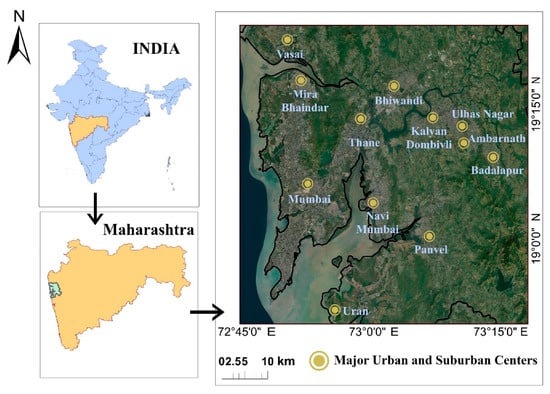
Figure 1.
Geographical location of the Mumbai and its surrounding suburban region.
Today, more than 20 million people are living in this region, and by the end of 2036, this number is expected to grow by 10.36 million [52]. According to the MMR Development Authority report, by 2036, approximately 5 million new housing units will require to accommodate the new householders [55]. These houses can be built by adopting an public private partnerships (PPP) approach [57,58]. Gridded data of probabilities of urban growth generated by Socioeconomic Data and Application Center (SEDAC) indicates that in the future, the central-eastern part of the MMR will become one of the most vulnerable areas in India. This region can experience the highest amount of urban expansion, with a probability of more than 80% (Figure 2). These probabilities of future urban expansion have calculated by using Monte Carlo model in which different variables such as population density, LULC maps, and values of gross domestic product were used as input [59].
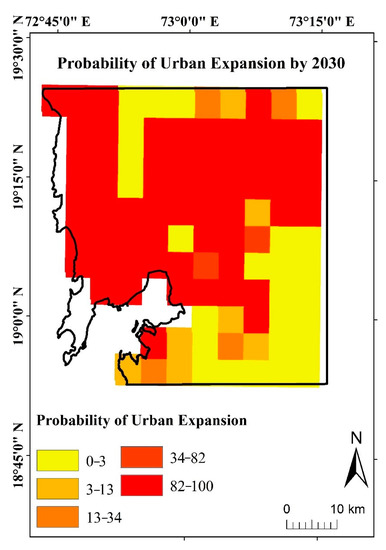
Figure 2.
Monte Carlo model-based estimated probabilities of urban expansion over study area by the Socioeconomic Data and Application Center (SEDAC) [59].
On the other hand, the 2016–2036 development plan of MMR also projected that due to the lack of space in the Mumbai region, the process of urbanization would shift to the areas located in the surrounding regions of Mumbai. It mainly includes suburban areas like Kalyan, Dombivli, Ambarnath, Badlapur, Ulhas Nagar, Vasai, Mira-Bhaindar, Thane, Navi-Mumbai, and Bhiwandi (Figure 1). As per the development plan of MMR, in the future, the regions, as mentioned above, will emerge as an urban growth center and experience the immense growth in the population and other real estate infrastructure. These projections show that shortly this area will undergo the rapid process of land transitions. Therefore, for management and planning activities, it is crucial to model the probable forthcoming changes in LULC pattern of Mumbai and its surrounding region.
2.2. Data
To evaluate and predict LULC, this work has been divided into two steps: (1) creation of spatiotemporal LULC maps from satellite images and (2) prediction of future LULC map using the historical LULC data to simulate the future fluctuations in LULC pattern and urban growth.
In the first step for the creation of spatiotemporal LULC maps, Landsat Archive L1 satellite data products for the years 1992, 2002, and 2011 were used. To avoid cloud distraction, cloud-free satellite images, which were mainly captured during the post-monsoon period, i.e., October–February, were collected. This dataset was acquired from the web portal of the United States Geological Survey (USGS).
During the second step, LULC maps, as well as maps of spatial drivers calculated with the aid of elevation and the dynamic transportation network and settlement data, were used to predict the spatial pattern of future LULC. In this process, digital elevation data obtained from Shuttle Radar Topography Mission (SRTM) were used. The SRTM elevation data represent one of the most widely used datasets, which is already tested in various studies for its quality and accuracy [60,61]. The vector dataset of the transportation network that mainly incorporates the dynamic layers of road and rail and metro train routes which were acquired from the Open Street Map (OSM) and development plan of MMR. The purpose, description, and other information of the data utilized for this research are summarized in Table 1.

Table 1.
The details of the dataset used.
3. Methodology
Figure 3 represents the general framework of the study consisted of two parts. Part “a” indicates the steps involved in the LULC creation and classification, while Part “b” depicts the procedure adopted for the LULC prediction. The detailed methodology is described in the following subsections.
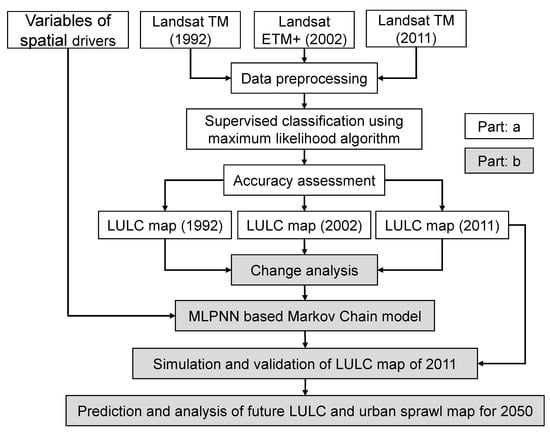
Figure 3.
General flowchart for land use and land cover (LULC) prediction consisted of two parts. Part (a) is for LULC generation and Part (b) is for LULC prediction.
3.1. Image Preprocessing and Classification
Before performing a LULC classification by using the raw Landsat satellite images, image preprocessing steps were implemented, which mainly include the geometric, radiometric, and atmospheric corrections. The Landsat images obtained for the years 1992, 2002, and 2011 were geometrically corrected with the aid of toposheets published by the Survey of India (SOI). Further, these images were reprojected by using WGS 84 datum with the geodetic system of Universal Transverse Mercator located in zone 43N. This process of geometric correction helps us to reduce the various types of image distortions [62]. In the next part, to get the accurate spectral reflectance values, the Fast Line-of-sight Atmospheric Analysis of Spectral Hypercubes (FLASSH) model available in ENVI4.5 software was used. After performing the image preprocessing, the training dataset for each LULC class was obtained by using the Google Earth images and field points. Finally, for each LULC class, a number of spectral signatures were extracted from the Landsat satellite images by using the training dataset. Each satellite image was classified by adopting the method of supervised classification with the Maximum Likelihood Classifier (MLC) algorithm. Through this method, images were classified mainly into five broad categories: Urban, Agricultural/Sparsely vegetated/Barren land, Water, Forest, and Coastal features. The detailed information about the classes is explained in Table 2. This entire process of image classification was performed using the ERDAS Imagine software (version 2015) (Hexagon AB, Stockholm, Sweden).

Table 2.
The details of the dataset used.
3.2. Accuracy Assessment of LULC Classification
Evaluating the accuracy of the classified images is an essential process in LULC classification. It fundamentally determines the quality of the classified LULC maps derived from the satellite imageries. In this evaluation, classified images were compared to another data, which is considered as accurate/ground truth data. The set of other data can be obtained from various sources such as field surveys, high-resolution satellite datasets, toposheets, and existing classified images.
In this study, an accuracy assessment was performed for the classified maps of the years 1992, 2002, and 2011. For this accuracy assessment, other than training samples, 200 distinct reference points were collected from the respective year’s archives of the Google Earth images, published classified maps [63], and field survey carried out by the authority of Greater Mumbai corporation authority. Further, these collected reference points were compared with the classified maps to generate the error matrix. An error matrix can measure accuracy in several different ways, i.e., overall, user, and producer accuracy. The proportion of correctly mapped reference sites compared to the total reference site represents the overall accuracy. The user accuracy evaluates the error of commission, which illustrates the probability of a classified map that depicts the reality. Producer accuracy measures the error of omission, which indicates how frequently actual features on the ground are accurately shown in the classified map. In addition to the accuracy assessment, the nonparametric kappa coefficient index (k) was calculated [64]. The kappa coefficient index is the proportion between the no. of accurately classified pixels and the total no. of pixels [64]. If the value of k ≥ 0.8, then it shows excellent agreement, while if it lies in between 0.4 and 0.6, then it shows the good agreement, and if k ≤ 0.4, then it shows the poor agreement [65]. The following Equation (1) was used for computing the kappa coefficient index [66].
where is total no. of observations, r is total no. of rows in the matrix, Xii is a number of observation in row i and column i, X+i is a marginal total of column i, and Xi+ is a marginal total of row i.
3.3. Prediction of Future LULC Pattern
Historical LULC transitions that have occurred during the periods 1992–2002 and 2002–2011 were used, respectively, to imitate and predict the forthcoming spatial pattern in LULC. Between the 2002–2011 period, Mumbai and its surrounding region experienced a rapid alteration in the LULC pattern; thus, to predict the future LULC of 2050, this period was considered. The Land Change Model (LCM) module of TerrSet 18.31, designed by Clark Lab, was employed for the prediction of future LULC. LCM primarily uses the MLPNN-MCM approach. It mainly considers the historical alterations in LULC and spatial explanatory variables that act as a spatial driver for the LULC modifications. The process involved in the prediction of future LULC can be segregated into the five steps: (i) LULC change analysis, (ii) evaluation and selection of explanatory variables, (iii) preparation of transition potential maps using MLPNN, (iv) prediction and validation of simulated LULC, and (v) application of the developed model to estimate the forthcoming pattern of LULC.
3.3.1. LULC Change Analysis
The change detection analysis step indicates the alterations from one LULC class to another type of LULC class during a precise period. Therefore, change detection analysis was carried out in LCM for three periods: 1992–2002, 2002–2011, and 1992–2011. As compared to the period of 1992–2002, rapid LULC changes over the study area were observed between 2002 and 2011. Subsequently, the prediction of future LULC (2050) was conducted with the help of the LULC alterations that occurred in the period 2002–2011, while LULC transitions between 1992 and 2002 were used to simulate the LULC of 2011. In this process, five major land transitions from each LULC class to other classes: (1) agricultural/sparsely vegetated and barren land to urban, (2) forest to urban, (3) agricultural/sparsely vegetated and barren land to forest, (4) coastal feature to urban, and (5) forest to agricultural/sparsely vegetated and barren land were considered. These LULC transitions further modeled as a submodel to improve the performance of the MLPNN. Additionally, for these three periods, the trend in spatial changes was plotted for observing the transition from all other classes to urban. The built-in module of spatial analysis within LCM was adopted to calculate the periodic spatial trend of change. During this process, the third-order polynomial function was utilized to produce the tendency plots, which was the most suitable fit for the changing pattern. The higher (lower) values of the spatial trend of change indicate the more (less) vagaries.
3.3.2. Evaluation and Selection of Spatial Drivers
Spatial drivers were evaluated and selected as an input to the LCM to produce the transition potential maps. These explanatory variables of LULC vary with location. There are mainly two types of explanatory variables viz. constrains and factors. The constraints are elucidated as a Boolean map, which is omitted from the forthcoming LULC alterations. During this research, the urban class was assigned as a constraint. It also acts as a pseudo-representative of various socioeconomic parameters such as population, economic activities, and job availability, which are difficult to produce at higher spatial resolution. Factors are the variables that decide the level of appropriateness for a region to alter. Here, factors were selected after evaluating their potential explanatory power by utilizing Cramer’s V test as shown in Equation (2). This test is one of the well-known nonparametric statistical tests that can measure the association between different variables. The values of the test vary between 0 and 1. The values closer to 1 depicts the higher relationship among the explanatory variable and definite transition categories, while values closer to 0 shows the poor relationship between them [67,68,69].
where is the sample size; is no. of rows or columns, whichever is the smaller; and is calculated from the Pearson chi-square test.
It has suggested to use variables with a Cramer’s V value ≥ 0.15, while if the Cramer’s V value of a factor is ≥ 0.4, then that factor can be the best to utilize [70]. With reference to earlier studies [26,27,71], mainly four variables were selected as a factor: elevation, slope, distance from transportation network, and distance from the existing urban area. For all these factors, the Cramer’s V value was >0.15. Figure 4 depicts the spatial pattern of various explanatory variables over Mumbai and its surrounding region.
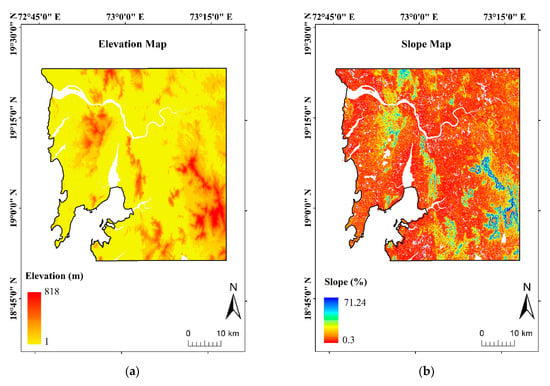
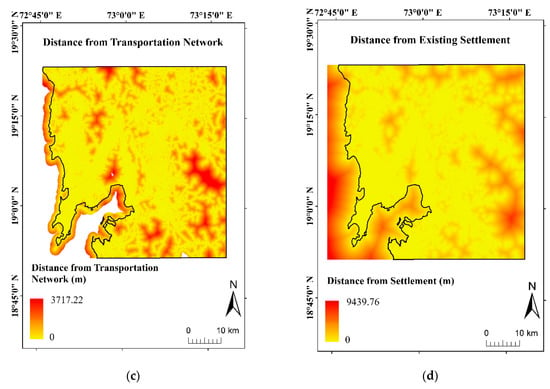
Figure 4.
Explanatory variables utilized in the study. (a) Elevation, (b) slope, (c) distance from the transportation network, and (d) distance from the existing settlement.
3.3.3. Preparation of Transition Potential
After testing the association of all factors with each land transition, the MLPNN based MCM model incorporated in LCM was implemented to generate the transition potential map. MLPNN is commonly used to model the complex nonlinear relationship between independent and dependent variables [72,73]. It is a feedforward type of ANN-based on a supervised backpropagation algorithm. It primarily contains three different layers, i.e., input, hidden, and output layers. Distribution of input data to neurons takes place through the input layer, while the corresponding result data can be obtained through the output layer. Out of these three layers, a hidden layer is situated among the input and output layers, which detect an alteration in the patterns between the input and output. During this process, each neuron computes the value derived from the product of values inside the nodes of the preceding layer and network weights among the nodes. Afterward, these derived values are given as an input to the activation function, such as sigmoid. Further, the backpropagation algorithm is adopted to train the neurons. This algorithm alters the weights of the neural network iteratively, so that error among the node’s outcome and the expected outcome is minimal. During this study, to estimate the transition potentials, MLPNN generates a random set of samples cells in every land transition submodel that have or have not experienced the LULC transition from one class to another. A further network of neurons with weights was formed using major land transitions and explanatory variables. Among these sample cells, 50% of the samples were reserved for the training and 50% for the testing. In the training process, the weights of each connection were adjusted to minimize the error. Finally, after running the MLPNN for a large number (10,000) of iterations, it has resulted in an accuracy rate. More than 80% of the accuracy rate is recommended [74]. After the successful execution of MLPNN, transition potentials were generated for each significant land transition. In the later part, these generated transition potentials were utilized to predict future LULC.
3.3.4. LULC Prediction and Validation
After the preparation of transition potential maps, LULC maps, the MCM was used to estimate the total amount of changes in the LULC pattern, and then it was utilized to evaluate the alterations during the course of prediction. This model has additionally assisted with computing the transition probability matrix, which demonstrates the likelihood of one LULC class changing to every other class for the foreseen period. Finally, created maps of transition potential maps and transition probabilities were utilized to predict the forthcoming spatial pattern of LULC. In this process, LULC of the year 2011 was imitated and validated with the actual LULC obtained for the same year, derived from the satellite image. This comparison between the actual and predicted maps was carried out by the kappa index statistics. For the validation, four different variations of kappa index were calculated: kappa for no information (kno), kappa for stratum level location (klocation strata), kappa standard (kstandard), and kappa for grid cell-level location (klocation) [75] (Table A1). This process of validation was executed using the Validation Module in Terr-Set software. After the validation of the simulated LULC of 2011, LULC of 2050 was predicted by considering the business-as-usual scenario. In this process we utilized 2002–2011 LULC data as a baseline scenario for comparison. Moreover, in the LULC prediction, the current water bodies, urban forest and coastal features like wetlands in Mumbai region are considered to be preserved following the various environmental norms by the Govt. of India and the local government.
4. Results and Discussion
4.1. LULC Classification and Accuracy Assessment
Figure 5 shows the classification results for the years 1992, 2002, and 2011. The accuracy and usability of these classified images were assessed by estimating the three kinds of accuracies (user, producer, and overall) and kappa statistics. Table 3 depicts an accuracy assessment for the LULC classified maps of the years 1992, 2002, and 2011. The overall accuracy of 1992, 2002, and 2011 LULC maps was noticed 87.56%, 85.57%, and 89.05%, respectively, fulfilling the criteria of minimum overall accuracy (i.e., greater than 85%) fixed by the USGS. The derived kappa coefficient for each classified map was higher than 0.80, which ensured the competence of classified maps for further analysis. As compared to other LULC categories, the class of coastal features, which includes wetland, mangroves, etc., illustrates the lower values of the user as well as producer accuracies (Table 3).
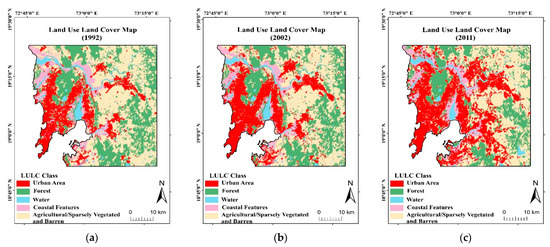
Figure 5.
LULC maps of (a) 1992, (b) 2002, and (c) 2011 obtained by processing the Landsat satellite images.

Table 3.
Accuracy assessment results of the LULC classification of the years 1992, 2002, and 2011.
These relatively lesser estimations of accuracy in the coastal features might be invigorated because of the temporal variations in the intertidal zone. Table 4 represents the area wise variation in LULC during the years 1992, 2002, and 2011. Between 1992 and 2011, the class of Agriculture/Sparsely Vegetated/Barren land is one of the leading categories of the LULC, followed by the forest and urban. In the entire period of 1992–2011, area-wise, urban is the only class that has experienced the increasing trend, whereas other classes have shown the declining tendency.

Table 4.
Area under each LULC class for the years 1992, 2002, and 2011.
It has been noticed that in 1992, the urban class covered an area of 494.52 km2 (17.44%) of the total area, while in the years 2002 and 2011, it was increased up to 671.50 km2 (23.69%) and 922.93 km2 (32.56%), respectively. On the other hand, between the year 1992–2011 area under the Agricultural/Sparsely Vegetated and Barren Land and Forest categories was reduced from 1089.51 km2 (38.44%) to 981.31 km2 (34.62%) and 874.08 km2 (30.84%) to 598.36 km2 (21.11%), respectively. In 1992, the total area covered by the coastal feature was 237.19 km2 (8.37%), which further decreased up to 199.62 km2 (7.04%) in 2002 and 194.48 km2 (6.86%) in 2011.
During this period of nineteen years, the alterations in the water class were not significant. The total area spanned by the water was 139.27 km2 (4.91%) in 1992, 135.31 km2 (4.77%) in 2002, and 137.50 km2 (4.85%) in 2011.
4.2. Analysis of Change Detection
Table 5 demonstrates the percentage and area-wise changes in different LULC classes over three periods: period 1 (1992–2002), period 2 (2002–2011), and period 3 (1992–2011), respectively. The first period, i.e., 1992–2002, has experienced a 35.79% increase in the Urban area, while the area of other classes, i.e., Forest, Water, Coastal Features, and Agricultural/Sparsely Vegetated and Barren, was decreased by 5.17%, 2.84%, 15.84%, and 8.26%, respectively. During this decade, the urban area is increased by 176.98 km2 in which contribution of land from Agricultural/Sparsely Vegetated and Barren (90.02 km2) was significant, followed by the Forest area (45.15 km2).

Table 5.
LULC change detection from 1992–2002, 2002–2011, and 1992–2011.
In the second period (2002–2011), rapid growth in an urban area was noticed over the central-southern and eastern regions of the study area. In comparison with the earlier decade (1992–2002), a similar magnitude of urban growth (37.44%) has observed during the second period. Except for the Urban and Water classes, other LULC classes have experienced a declining trend in the area, in which a significant decrease has occurred within the Forest class. Throughout the second period, the total area under the forest class was reduced by 31.54% (275.72 km2). Between 1992 and 2011, the overall urban area was expanded by 428.41 km2 (86.63%), while other classes indicate the decreasing trend. Subsequently, for these three periods, the spatial trend of change was derived, which mainly represents the general spatial pattern of LULC.
Figure 6a–c depicts the spatial trend of change from all other classes to an urban area. Figure 6a illustrates that during the first period, a transition of the urban area was concentrated over the Mumbai City and its northern parts, whereas in the second period, it has shifted to the suburban regions of the Mumbai which are situated in the eastward part of the study region.
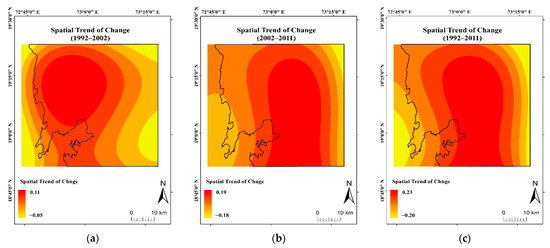
Figure 6.
Alterations in spatial trend of change for the period of (a) 1992–2002, (b) 2002–2011, and (c) 1992–2011.
Similar to the second period, the spatial trend of change was mapped for the entire duration (1992–2011). It has also illustrated the tendency of the intense transition into the urban region is mainly occurring around suburban parts of the Mumbai city. In this period of 29 years, due shortage of land within the Mumbai city, most of the urban expansion was observed over the suburbs of the city. This rapid growth in the suburbs can be attributed to the many causes like the availability of jobs, business opportunities, and excellent local train networks.
4.3. Prediction and Validation of 2011 LULC
In this study, the MLPNN-based MCM has adopted to predict the future spatial pattern of LULC. LULC of 1992 and 2002 were utilized to simulate the LULC of the year 2011 (Figure 7). In this process, transition potentials were computed by executing the MLPNN technique with an accuracy rate of 81.69%, whereas with the aid of MCM transition probability matrix was calculated. Table 6 demonstrates the class-wise values of transition probabilities between 1992 and 2002, which was further used to model the LULC pattern of 2011.
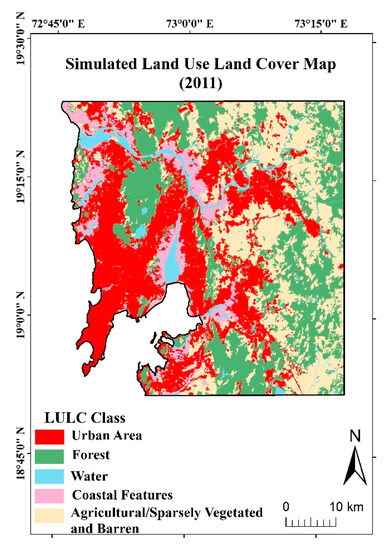
Figure 7.
Simulated LULC for the year 2011.

Table 6.
Markov transition probability used for 2011 LULC simulation, representing alterations between LULC classes.
It is noticeable that during 1992–2002 the probability of change of coastal land to urban land was higher (0.1340), followed by the Agricultural/Sparsely Vegetated and Barren class (0.1171). Afterward, by using these outputs from the MLPNN and MCM, the LULC map for the year 2011 was simulated (Figure 7). To validate the simulated LULC of 2011, percentage wise area statistics of actual and simulated LULC of 2011 were compared and chi-square test was performed to assess the forecasting ability of model. Table 7 depicts the detail results of chi-square test. In this process, we assumed that area statistics of actual and simulated LULC of 2011 were the same.

Table 7.
Forecasting assessment of MLPNN-MCM approach based on the actual and simulated LULC pattern of 2011.
However, this test does not necessarily verify the spatial distribution of LULC categories of the study area. To overcome on this problem, four kappa coefficients, kno, kstandard, klocation, and klocation strata, were computed. The values of each kappa coefficient were higher than 0.75 (Table 8). The achieved values of kappa coefficients indicate that the applied model and its composition are feasible to predict the future pattern of LULC.

Table 8.
Kappa scores for the validation of the simulated LULC of 2011.
4.4. Prediction of 2050 LULC
In the prediction of 2050 LULC (Figure 8), the transition potentials and transition probabilities in Table 9 estimated from the 2002–2011 LULC data were utilized. Table 9 indicates that in the future as compared to other classes, Agricultural/Sparsely Vegetated and Barren class has leading (0.3159) probability of changing into Urban. Table 10 demonstrates the area-wise comparative LULC statistics for the years 2011 and 2050. It indicates that as compared to 2011, the total area under Urban, Forest, and Coastal feature classes would be increased by 405.84 km2 (43.97%), 58.27 km2 (9.73%), and 15.57 km2 (8.00%), respectively. Between 2011 and 2050, land under the Agricultural/Sparsely Vegetated and Barren class is expected to reduce rapidly from 981.31 km2 to 503.20 km2. As compared to 2011, by the year 2050, an area covered by the Water class shows the minute declination of 1.58 km2 (1.14%). These alterations in the future pattern of LULC are maybe the response of ongoing and proposed development of this region in the various sectors (industrial, infrastructure, transportation, etc.).
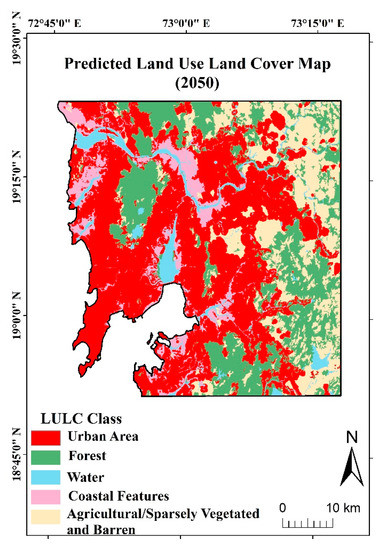
Figure 8.
Predicted LULC Map for the year 2050.

Table 9.
Markov transition probability used for 2050 LULC simulation, representing alterations between LULC classes.

Table 10.
LULC change detection from 2011 to 2050.
4.5. Spatial Trend of Urban Growth
For the years of 1992, 2002, 2011, and 2050, the urban sprawl map has been created (Figure 9) to evaluate the spatio-temporal alterations in the extent of urban growth. Figure 9 illustrates that in the period of 1992–2002, some parts of Mumbai City have faced the infilling type of urban growth, which enhanced the continuity of urban areas of Mumbai City. In this period, significant growth has been observed around transportation networks (rail, highways, etc.). During the second period from 2002 to 2011, most of the suburban regions like Navi Mumbai, Thane, Kalyan Bhiwandi, Rasayni, and Panvel confronted a noticeable urban expansion. The enormous growth in the region of Navi Mumbai was mainly occurred due to its status of special economic zone, a proposed airport, and its excellent transportation connectivity with the other cities. Between 2002 and 2011, the urban growth was detected over the Thane and Kalyan region. Over these areas, the expanding trend of urbanization can be accredited to industrialization. Rural–urban migration, development of Mumbai–Agra highway, and the emergence of Bhiwandi as a transportation hub are some of the factors that might have triggered the urban growth over the southern part of Bhiwandi. During this entire decade, the development of eastern and western express highways elicits the urban growth of the various suburban regions like Kalyan, Thane, Bhiwandi, and Navi Mumbai. In the same decade, an expansion of Jawaharlal Nehru Port Trust (JNPT) was maybe one of the inducing reasons of urban growth over the southern parts of the study area (Panvel, Rasayni, and Uran). In the third period, i.e., 2011–2050, the dense edge expansion and infill type of urban growth would be experienced by the regions that were developed during the second period. In general, it is noticed that the historical and projected pattern of urban growth is mainly associated with transportation and industrial development. This dataset (Figure 9) also provides the future probable boundaries between urban and non-urban areas which can be useful for policy makers to make strategies to enhance the urban–rural connectivity for augmenting the supply chain interactions and economy.
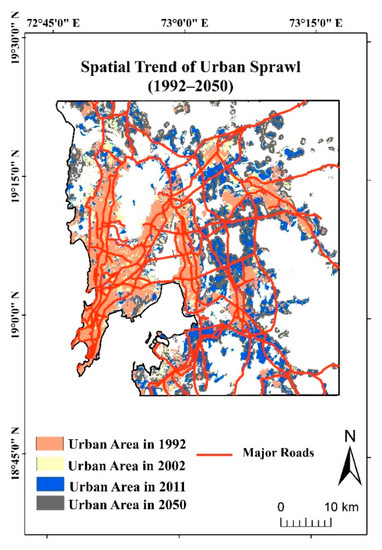
Figure 9.
Spatio-temporal trend of urban growth between 1992 and 2050.
5. Conclusions
The current study has been carried out to understand the alterations in the historical and projected LULC patterns from the year 1992 to 2050. To undertake this analysis, an integrated approach of GIS, remote sensing, and MLPNN based MCM model has been utilized. As far as authors are aware that the performance of the MLPNN-MCM has not assessed previously over this study area; therefore, this research will also help to assess the performance of the MLPNN-MCM approach over Mumbai and its surrounding region. Subsequently, the outcomes of this study will also help to produce the future LULC pattern, which can help in the sustainable management of urban areas. The main inferences of the study are as follows.
(1) The prediction result for 2050 provides the number of changes and also gives the spatial locations of the probable changes. These results indicate that from 2011 to 2050 there would be a substantial amount of increase in Urban class (405.84 km2), whereas a considerable amount of reduction can occur in Agricultural/Sparsely Vegetated land (478.11 km2).
(2) By 2050, the Urban class will cover the area of 1328.77 km2, which is 46.87% of the entire study area while Agricultural/Sparsely Vegetated land, Coastal feature, Forest and Water categories will occupy the 17.75%, 7.41%, 23.16%, and 4.79%, respectively.
(3) From 1992 to 2050, most of the past and probable future urban sprawl is significantly associated with the major roads, which indicates that the road network is among the major key factors that elicited the urban growth.
(4) The south and western part of Mumbai City is surrounded by ocean; therefore, throughout the past and future time span, the trend of urban expansion is mainly observed over the suburban regions of the study area, i.e., North-Eastern, South Eastern, and Eastern parts.
(5) The result of this study also depicts the usefulness of MLPNN based MCM to quantify and visualize the future LULC patterns. However, it is still challenging to integrate various other factors (socioeconomic data, the policy of the government, etc.) in this LULC prediction model. Thus, in the future, there will be a scope to modify these models for better accuracy.
In this study, the LULC prediction for 2050 was carried out to give sufficient timeframe to local authorities for policy-making, revision, and implementation with a foresight of its usefulness in sustainable planning, rather than making a short-term prediction. However, it also raises an issue that the probability of which the predicted LULC could be happen in real in 2050 is less likely under given socio-economic environment as geophysical factors are only considered in the prediction. This is a part of the limitations of this study and a direction of future work by considering the more various socio-economic and political factors for urban expansion.
Estimated future LULC changes over Mumbai and its surrounding region can alter the various climatic and environmental processes. For example, the rapid expansion of urban areas can alter the different physical/biophysical parameters (leaf area index, albedo, and sky view factor) of the region, which are capable to alter the micrometeorology of the study area by disturbing the land–atmosphere interaction.
Thus, it is a necessity to develop some policies and strategies to achieve the goals for sustainable development and urban planning, which can minimize the adverse effects induced by those changes. A correct or appropriate territorial planning can actually be able to govern the transformation of the region. This is one of purposes of this study to quantitatively and qualitatively show how this kind of LULC prediction can show the effects of a scenario-based guideline/policies on urban transformation. Moreover, the spatial information obtained from these kinds of research will be helpful to various stakeholders such as urban planners, meteorologists, and policy-makers to formulate the local and regional scale strategies required for sustainable development.
Author Contributions
Conceptualization, method development, investigation, resources, writing, and visualization: B.V. and H.S.L.; supervision: H.S.L. and S.G. All authors have read and agreed to the published version of the manuscript.
Funding
This study is supported by the Japan–India International Linkage Degree Program (ILDP) (K190112) as well as the DST-INSPIRE program (DST/INSPIRE/03/2015/005692 IF160608) at Hiroshima University and IIT Bombay.
Institutional Review Board Statement
Not applicable.
Informed Consent Statement
Not applicable.
Data Availability Statement
Not applicable.
Acknowledgments
We thank all the lab members from the CHESS lab and Geomatics lab for their continuous support.
Conflicts of Interest
The authors declare no conflict of interest.
Appendix A

Table A1.
Description of Kappa statistics used in the validation of predicted LULC of 2011.
Table A1.
Description of Kappa statistics used in the validation of predicted LULC of 2011.
| Type of Kappa Coefficient | Description |
|---|---|
| Kappa for no-information (kno) | kno is the ratio among accurately classified pixels to the anticipated proportion of pixels |
| Kappa for grid-cell-location (klocation) | It represents the spatial-level correctness associated with the level of location-wise agreement |
| Cohen’s Kappa statistics (kstandard) | kstandard is the proportion of accurately assigned pixels to the proportion may be accurate by chance |
| Kappa for stratum-level-location (klocation strata) | klocation strata is an accuracy-related with the accurate assignment predefined strata |
More information about the above-mentioned kappa coefficients has given in the [64,76].
References
- Hassan, Z.; Shabbir, R.; Ahmad, S.S.; Malik, A.H.; Aziz, N.; Butt, A.; Erum, S. Dynamics of land use and land cover change (LULCC) using geospatial techniques: A case study of Islamabad Pakistan. SpringerPlus 2016, 5. [Google Scholar] [CrossRef] [PubMed]
- Matlhodi, B.; Kenabatho, P.K.; Parida, B.P.; Maphanyane, J.G. Evaluating land use and land cover change in the Gaborone dam catchment, Botswana, from 1984–2015 using GIS and remote sensing. Sustainability 2019, 11, 5174. [Google Scholar] [CrossRef]
- Cihlar, J. Land cover mapping of large areas from satellites: Status and research priorities. Int. J. Remote Sens. 2000, 21, 1093–1114. [Google Scholar] [CrossRef]
- Vitousek, P.M.; Mooney, H.A.; Lubchenco, J.; Melillo, J.M. Human domination of Earth’s ecosystems. Science 1997, 277, 494–499. [Google Scholar] [CrossRef]
- Shi, G.; Jiang, N.; Yao, L. Land use and cover change during the rapid economic growth period from 1990 to 2010: A case study of Shanghai. Sustainability 2018, 10, 426. [Google Scholar] [CrossRef]
- Paul, S.; Ghosh, S.; Mathew, M.; Devanand, A.; Karmakar, S.; Niyogi, D. Increased Spatial Variability and Intensification of Extreme Monsoon Rainfall due to Urbanization. Sci. Rep. 2018, 8, 1–10. [Google Scholar] [CrossRef]
- Gogoi, P.P.; Vinoj, V.; Swain, D.; Roberts, G.; Dash, J.; Tripathy, S. Land use and land cover change effect on surface temperature over Eastern India. Sci. Rep. 2019, 9, 1–10. [Google Scholar] [CrossRef]
- Zhong, S.; Qian, Y.; Zhao, C.; Leung, R.; Wang, H.; Yang, B.; Fan, J.; Yan, H.; Yang, X.Q.; Liu, D. Urbanization-induced urban heat island and aerosol effects on climate extremes in the Yangtze River Delta region of China. Atmos. Chem. Phys. 2017, 17, 5439–5457. [Google Scholar] [CrossRef]
- Deshmukh, D.S.; Chaube, U.C.; Ekube Hailu, A.; Aberra Gudeta, D.; Tegene Kassa, M. Estimation and comparision of curve numbers based on dynamic land use land cover change, observed rainfall-runoff data and land slope. J. Hydrol. 2013, 492, 89–101. [Google Scholar] [CrossRef]
- Xu, X.; Xie, Y.; Qi, K.; Luo, Z.; Wang, X. Detecting the response of bird communities and biodiversity to habitat loss and fragmentation due to urbanization. Sci. Total Environ. 2018, 624, 1561–1576. [Google Scholar] [CrossRef]
- Mortoja, M.G.; Yigitcanlar, T. Local drivers of anthropogenic climate change: Quantifying the impact through a remote sensing approach in Brisbane. Remote Sens. 2020, 12, 2270. [Google Scholar] [CrossRef]
- Mortoja, M.G.; Yigitcanlar, T. How Does Peri-Urbanization Trigger Climate Change Vulnerabilities? An Investigation of the Dhaka Megacity in Bangladesh. Remote Sens. 2020, 12, 3938. [Google Scholar] [CrossRef]
- Xystrakis, F.; Psarras, T.; Koutsias, N. A process-based land use/land cover change assessment on a mountainous area of Greece during 1945–2009: Signs of socio-economic drivers. Sci. Total Environ. 2017, 587–588, 360–370. [Google Scholar] [CrossRef] [PubMed]
- Demeritt, D.; Wainwright, J. Models, Modelling, and Geography. Quest. Geogr. Fundam. Debates 2005, 206–225. [Google Scholar] [CrossRef]
- Saadat, H.; Adamowski, J.; Bonnell, R.; Sharifi, F.; Namdar, M.; Ale-Ebrahim, S. Land use and land cover classification over a large area in Iran based on single date analysis of satellite imagery. ISPRS J. Photogramm. Remote Sens. 2011, 66, 608–619. [Google Scholar] [CrossRef]
- Aghsaei, H.; Mobarghaee Dinan, N.; Moridi, A.; Asadolahi, Z.; Delavar, M.; Fohrer, N.; Wagner, P.D. Effects of dynamic land use/land cover change on water resources and sediment yield in the Anzali wetland catchment, Gilan, Iran. Sci. Total Environ. 2020, 712, 136449. [Google Scholar] [CrossRef]
- Cromley, R.G.; Hanink, D.M. Coupling land use allocation models with raster GIS. J. Geogr. Syst. 1999, 1, 137–153. [Google Scholar] [CrossRef]
- Sahebgharani, A. Multi-objective land use optimization through parallel particle swarm algorithm: Case study Baboldasht district of Isfahan, Iran. J. Urban Environ. Eng. 2016, 10, 42–49. [Google Scholar] [CrossRef]
- Mahmoud, M.I.; Duker, A.; Conrad, C.; Thiel, M.; Ahmad, H.S. Analysis of settlement expansion and urban growth modelling using geoinformation for assessing potential impacts of urbanization on climate in Abuja City, Nigeria. Remote Sens. 2016, 8, 220. [Google Scholar] [CrossRef]
- Losiri, C.; Nagai, M.; Ninsawat, S.; Shrestha, R.P. Modeling urban expansion in Bangkok Metropolitan region using demographic-economic data through cellular Automata-Markov Chain and Multi-Layer Perceptron-Markov Chain models. Sustainability 2016, 8, 686. [Google Scholar] [CrossRef]
- Zhou, Y.; Varquez, A.C.G.; Kanda, M. High-resolution global urban growth projection based on multiple applications of the SLEUTH urban growth model. Sci Data 2019, 6, 34. [Google Scholar] [CrossRef] [PubMed]
- Abdulrahman, A.I.; Ameen, S.A. Predicting Land use and land cover spatiotemporal changes utilizing CA-Markov model in Duhok district between 1999 and 2033. Acad. J. Nawroz Univ. 2020, 9, 71–80. [Google Scholar] [CrossRef]
- Liping, C.; Yujun, S.; Saeed, S. Monitoring and predicting land use and land cover changes using remote sensing and GIS techniques—A case study of a hilly area, Jiangle, China. PLoS ONE 2018, 13, e0200493. [Google Scholar] [CrossRef] [PubMed]
- Mondal, B.; Das, D.N.; Bhatta, B. Integrating cellular automata and Markov techniques to generate urban development potential surface: A study on Kolkata agglomeration. Geocarto Int. 2017, 32, 401–419. [Google Scholar] [CrossRef]
- QuanLi, X.; Kun, Y.; GuiLin, W.; YuLian, Y. Agent-based modeling and simulations of land-use and land-cover change according to ant colony optimization: A case study of the Erhai Lake Basin, China. Nat. Hazards 2015, 75, 95–118. [Google Scholar] [CrossRef]
- Mishra, V.N.; Rai, P.K. A remote sensing aided multi-layer perceptron-Markov chain analysis for land use and land cover change prediction in Patna district (Bihar), India. Arab. J. Geosci. 2016, 9. [Google Scholar] [CrossRef]
- Mishra, V.N.; Rai, P.K.; Prasad, R.; Punia, M.; Nistor, M.M. Prediction of spatio-temporal land use/land cover dynamics in rapidly developing Varanasi district of Uttar Pradesh, India, using geospatial approach: A comparison of hybrid models. Appl. Geomat. 2018, 10, 257–276. [Google Scholar] [CrossRef]
- Saputra, M.H.; Lee, H.S. Prediction of land use and land cover changes for North Sumatra, Indonesia, using an artificial-neural-network-based cellular automaton. Sustainability 2019, 11, 3024. [Google Scholar] [CrossRef]
- Rahman, M.T.U.; Tabassum, F.; Rasheduzzaman, M.; Saba, H.; Sarkar, L.; Ferdous, J.; Uddin, S.Z.; Zahedul Islam, A.Z.M. Temporal dynamics of land use/land cover change and its prediction using CA-ANN model for southwestern coastal Bangladesh. Environ. Monit. Assess. 2017, 189. [Google Scholar] [CrossRef]
- Balzter, H. Markov chain models for vegetation dynamics. Ecol. Modell. 2000, 126, 139–154. [Google Scholar] [CrossRef]
- Triantakonstantis, D.; Mountrakis, G. Urban Growth Prediction: A Review of Computational Models and Human Perceptions. J. Geogr. Inf. Syst. 2012, 4, 555–587. [Google Scholar] [CrossRef]
- Araya, Y.H.; Cabral, P. Analysis and modeling of urban land cover change in Setúbal and Sesimbra, Portugal. Remote Sens. 2010, 2, 1549–1563. [Google Scholar] [CrossRef]
- Feng, H.H.; Liu, H.P.; Lü, Y. Scenario Prediction and Analysis of Urban Growth Using SLEUTH Model. Pedosphere 2012, 22, 206–216. [Google Scholar] [CrossRef]
- Hosseinali, F.; Alesheikh, A.A.; Nourian, F. Assessing urban land-use development: Developing an agent-based model. KSCE J. Civ. Eng. 2014, 19, 285–295. [Google Scholar] [CrossRef]
- Yang, X.; Chen, R.; Zheng, X.Q. Simulating land use change by integrating ANN-CA model and landscape pattern indices. Geomat. Nat. Hazards Risk 2016, 7, 918–932. [Google Scholar] [CrossRef]
- National Research Council. Advancing Land Change Modeling: Opportunities and Research Requirements; The National Academies Press: Washington, DC, USA, 2014; ISBN 978-0-309-28833-0. [Google Scholar]
- Ansari, A.; Golabi, M.H. Prediction of spatial land use changes based on LCM in a GIS environment for Desert Wetlands—A case study: Meighan Wetland, Iran. Int. Soil Water Conserv. Res. 2019, 7, 64–70. [Google Scholar] [CrossRef]
- Pahlavani, P.; Omran, H.A.; Bigdeli, B. A multiple land use change model based on artificial neural network, Markov chain, and multi objective land allocation. EOGE 2017, 1, 82–99. [Google Scholar] [CrossRef]
- Halmy, M.W.A.; Gessler, P.E.; Hicke, J.A.; Salem, B.B. Land use/land cover change detection and prediction in the north-western coastal desert of Egypt using Markov-CA. Appl. Geogr. 2015, 63, 101–112. [Google Scholar] [CrossRef]
- Ghosh, P.; Mukhopadhyay, A.; Chanda, A.; Mondal, P.; Akhand, A.; Mukherjee, S.; Nayak, S.K.; Ghosh, S.; Mitra, D.; Ghosh, T.; et al. Application of Cellular automata and Markov-chain model in geospatial environmental modeling—A review. Remote Sens. Appl. Soc. Environ. 2017, 5, 64–77. [Google Scholar] [CrossRef]
- Ku, C.A. Incorporating spatial regression model into cellular automata for simulating land use change. Appl. Geogr. 2016, 69, 1–9. [Google Scholar] [CrossRef]
- Mozumder, C.; Tripathi, N.K. Geospatial scenario based modelling of urban and agricultural intrusions in Ramsar wetland deepor beel in northeast India using a multi-layer perceptron neural network. Int. J. Appl. Earth Obs. Geoinf. 2014, 32, 92–104. [Google Scholar] [CrossRef]
- Mas, J.F.; Flores, J.J. The application of artificial neural networks to the analysis of remotely sensed data. Int. J. Remote Sens. 2008, 29, 617–663. [Google Scholar] [CrossRef]
- Atkinson, P.M.; Tatnall, A.R.L. Introduction Neural networks in remote sensing. Int. J. Remote Sens. 1997, 18, 699–709. [Google Scholar] [CrossRef]
- Hu, X.; Weng, Q. Estimating impervious surfaces from medium spatial resolution imagery using the self-organizing map and multi-layer perceptron neural networks. Remote Sens. Environ. 2009, 113, 2089–2102. [Google Scholar] [CrossRef]
- Parsamehr, K.; Gholamalifard, M.; Kooch, Y. Comparing three transition potential modeling for identifying suitable sites for REDD+ projects. Spat. Inf. Res. 2020, 28, 159–171. [Google Scholar] [CrossRef]
- Bhatti, S.S.; Tripathi, N.K.; Nitivattananon, V.; Rana, I.A.; Mozumder, C. A multi-scale modeling approach for simulating urbanization in a metropolitan region. Habitat Int. 2015, 50, 354–365. [Google Scholar] [CrossRef]
- Silva, R.F.B.d.; Batistella, M.; Moran, E.F. Drivers of land change: Human-environment interactions and the Atlantic forest transition in the Paraíba Valley, Brazil. Land Use Policy 2016, 58, 133–144. [Google Scholar] [CrossRef]
- Chim, K.; Tunnicliffe, J.; Shamseldin, A.; Ota, T. Land use change detection and prediction in upper Siem Reap River, Cambodia. Hydrology 2019, 6, 64. [Google Scholar] [CrossRef]
- Shoyama, K.; Matsui, T.; Hashimoto, S.; Kabaya, K.; Oono, A.; Saito, O. Development of land-use scenarios using vegetation inventories in Japan. Sustain. Sci. 2019, 14, 39–52. [Google Scholar] [CrossRef]
- Vadrevu, K.P.; Justice, C.; Prasad, T.; Prasad, N.; Gutman, G. Land cover/land use change and impacts on environment in South Asia. J. Environ. Manag. 2015, 148, 1–3. [Google Scholar] [CrossRef]
- Nayak, S.; Mandal, M. Impact of land-use and land-cover changes on temperature trends over Western India. Curr. Sci. 2012, 102, 1166. [Google Scholar]
- Mohammed Hamud, A.; Mobarak Prince, H.; Zulhaidi Shafri, H. Landuse/Landcover mapping and monitoring using Remote sensing and GIS with environmental integration. IOP Conf. Ser. Earth Environ. Sci. 2019, 357, 012038. [Google Scholar] [CrossRef]
- Census of India. Econ. Polit. Wkly. 2011, 46, 5. Available online: https://www.epw.in/journal/2011/04/letters/census-india-2011.html (accessed on 1 December 2020).
- MMRDA. Mumbai Metropolitan Regional Plan; MMRDA: Mumbai, India, 2016. [Google Scholar]
- Compare Infobase Limited No Title. Available online: https://web.archive.org/web/20071011200913/http://mapsofindia.com/maps/maharashtra/mumbai-city.html/ (accessed on 1 December 2020).
- Battisti, F.; Campo, O.; Forte, F. A methodological approach for the assessment of potentially buildable land for tax purposes: The Italian case study. Land 2020, 9, 8. [Google Scholar] [CrossRef]
- Guarini, M.R.; Battisti, F. A model to assess the feasibility of public-private partnership for social housing. Buildings 2017, 7, 44. [Google Scholar] [CrossRef]
- Seto, K.C.; Güneralp, B.; Hutyra, L.R. Global forecasts of urban expansion to 2030 and direct impacts on biodiversity and carbon pools. Proc. Natl. Acad. Sci. USA 2012, 109, 16083–16088. [Google Scholar] [CrossRef]
- Liu, Y. An evaluation on the data quality of SRTM DEM at the alpine and plateau area, north-western of China. Int. Arch. Photogramm. Remote Sens. Spat. Inf. Sci. 2008, XXXVI, 1123–1128. [Google Scholar]
- Smith, B.; Sandwell, D. Accuracy and resolution of shuttle radar topography mission data. Geophys. Res. Lett. 2003, 30, 3–6. [Google Scholar] [CrossRef]
- Toutin, T. Geometric Correction of Remotely Sensed Images BT—Remote Sensing of Forest Environments: Concepts and Case Studies; Wulder, M.A., Franklin, S.E., Eds.; Springer US: Boston, MA, USA, 2003; pp. 143–180. ISBN 978-1-4615-0306-4. [Google Scholar]
- Mendiratta, P.; Gedam, S. Assessment of urban growth dynamics in Mumbai Metropolitan Region, India using object-based image analysis for medium-resolution data. Appl. Geogr. 2018, 98, 110–120. [Google Scholar] [CrossRef]
- Cohen, J. A Coefficient of Agreement for Nominal Scales. Educ. Psychol. Meas. 1960, 20, 37–46. [Google Scholar] [CrossRef]
- Foody, G.M. Thematic map comparison: Evaluating the statistical significance of differences in classification accuracy. Photogramm. Eng. Remote Sens. 2004, 70, 627–633. [Google Scholar] [CrossRef]
- Hudson, W.D.; Ramm, C.W. Correct formulation of the Kappa coefficient of agreement (in remote sensing). Photogramm. Eng. Remote Sens. 1987, 53, 421–422. [Google Scholar]
- Liebetrau, A.M. Measures of Association; Sage: Newcastle upon Tyne, UK, 1983; Volume 32, ISBN 0803919743. [Google Scholar]
- Oñate-Valdivieso, F.; Bosque Sendra, J. Application of GIS and remote sensing techniques in generation of land use scenarios for hydrological modeling. J. Hydrol. 2010, 395, 256–263. [Google Scholar] [CrossRef]
- Islam, K.; Rahman, M.F.; Jashimuddin, M. Modeling land use change using Cellular Automata and Artificial Neural Network: The case of Chunati Wildlife Sanctuary, Bangladesh. Ecol. Indic. 2018, 88, 439–453. [Google Scholar] [CrossRef]
- Eastman, J.R. IDRISI Terrset Manual; Clark Labs, Clark University: Worcester, MA, USA, 2016. [Google Scholar]
- Shastri, H.; Ghosh, S.; Paul, S.; Shafizadeh-Moghadam, H.; Helbich, M.; Karmakar, S. Future urban rainfall projections considering the impacts of climate change and urbanization with statistical–dynamical integrated approach. Clim. Dyn. 2019, 52, 6033–6051. [Google Scholar] [CrossRef]
- Sangermano, F.; Eastman, J.R.; Zhu, H. Similarity Weighted Instance-based Learning for the Generation of Transition Potentials in Land Use Change Modeling. Trans. GIS 2010, 14, 569–580. [Google Scholar] [CrossRef]
- Eastman, J.R. Idrisi Selva Tutorial, Idrisi Prod; Clark LabsClark University: Worcester, MA, USA, 2012; Volume 45, pp. 51–63. [Google Scholar]
- Eastman, J.R. IDRISI Andes guide to GIS and Image Processing; Clark LabsClark University: Worcester, MA, USA, 2006; Volume 328. [Google Scholar]
- Pontius, R.G.; Cornell, J.D.; Hall, C.A.S. Modeling the spatial pattern of land-use change with GEOMOD2: Application and validation for Costa Rica. Agric. Ecosyst. Environ. 2001, 85, 191–203. [Google Scholar] [CrossRef]
- Pontius, R.G. Statistical methods to partition effects of quantity and location during comparison of categorical maps at multiple resolutions. Photogramm. Eng. Remote Sens. 2002, 68, 1041–1049. [Google Scholar]
Publisher’s Note: MDPI stays neutral with regard to jurisdictional claims in published maps and institutional affiliations. |
© 2021 by the authors. Licensee MDPI, Basel, Switzerland. This article is an open access article distributed under the terms and conditions of the Creative Commons Attribution (CC BY) license (http://creativecommons.org/licenses/by/4.0/).